Krishnadevaraya
| Krishnadevaraya | |
|---|---|
| Maharajadhiraja Kannada Rajya Rama Ramana Andhra Bhoja Dakshinasamudradhiswara Mooru Rayara Ganda[1] Abhinava-Bhoja[2] Gaubrahmana Pratipalaka | |
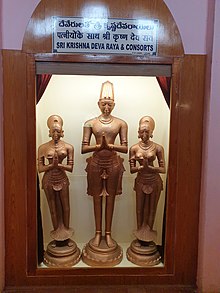 Sculpture of Krishnadevaraya and his wives at Chandragiri Museum | |
| Vijayanagara Emperor | |
| Reign | 26 July 1509 – 17 October 1529[3] |
| Coronation | 23/24 January 1510[4][a] |
| Predecessor | Viranarasimha Raya |
| Successor | Achyuta Deva Raya |
| Born | 17 January 1471 Vijayanagara, Vijayanagara Empire (modern day Hampi, Karnataka, India) |
| Died | 17 October 1529 (aged 58) Vijayanagara, Vijayanagara Empire (modern day Hampi, Karnataka, India) |
| Consort | Tirumala Devi Chinna Devi Annapurna Devi |
| Issue | |
| Dynasty | Tuluva |
| Father | Tuluva Narasa Nayaka |
| Mother | Nagala Devi |
| Religion | Hinduism |

Krishnadevaraya (17 January 1471 – 17 October 1529) was emperor of the Vijayanagara Empire from 1509 to 1529. He was the third monarch of the Tuluva dynasty, and is considered to be one of the greatest rulers in Indian history.[7] He ruled the largest empire in India after the fall of the Islamic Delhi Sultanate.[8] Presiding over the empire at its zenith, he is regarded as an icon by many Indians. Krishnadevaraya earned the titles Andhra Bhoja (lit. "Bhoja of Andhra"), Karnatakaratna Simhasanadeeshwara (lit. "Lord of the Jewelled Throne of Karnataka"), Yavana Rajya Pratistapanacharya (lit. "Establishment of the King to Bahmani Throne"), Kannada Rajya Rama Ramana (lit. "Lord of the Kannada Empire), Gaubrahmana Pratipalaka (lit. "Protector of Brahmins and Cows") and Mooru Rayara Ganda (lit. "Lord of Three Kings"). He became the dominant ruler of the peninsula by defeating the sultans of Bijapur, Golconda, the Bahmani Sultanate and the Gajapatis of Odisha, and was one of the most powerful Hindu rulers in India.[1]
Krishnadevaraya's rule was characterised by expansion and consolidation. This was the time when the land between the Tungabhadra and Krishna river (the Raichur doab) was acquired (1512), ruler of Odisha were subdued (1514) and severe defeats were inflicted on the Sultan of Bijapur (1520).
When the Mughal Emperor Babur was taking stock of the potentates of north India, he rated Krishnadevaraya the most powerful, with the most extensive empire in the subcontinent.[8] The Portuguese travellers Domingo Paes and Duarte Barbosa visited the Vijayanagara Empire during his reign, and their travelogues indicate that the king was not only an able administrator but also an excellent general, leading from the front in battle and even attending to the wounded. On many occasions, the king changed battle plans abruptly, turning a losing battle into victory. The poet Mukku Timmanna praised him as the 'Destroyer of the Turks.'[9] Krishnadevaraya benefited from the counsel of his prime minister Timmarusu, whom he regarded as the father figure responsible for his coronation. Krishnadevaraya was also advised by the witty Tenali Ramakrishna, who was employed in his court.
Early life
Krishnadevaraya was the son of Tuluva Narasa Nayaka[10][11] and his queen Nagamamba.[12][13] Tuluva Narasa Nayaka was an army commander under Saluva Narasimha Deva Raya, who later took control to prevent the disintegration of the empire and established the Tuluva dynasty of the Vijayanagara Empire. He accessed the throne after the death of his brother Viranarasimha.[14][citation needed] He was married to Srirangapatna's princess Tirumala Devi and his royal dancer from Kodagu, Chinna Devi.[citation needed] He was father to Tirumalamba (from Tirumala Devi), Vengalamba (from Chinna Devi) and Tirumala Raya (from Tirumala Devi). His daughters were married to Prince Rama Raya of Vijayanagara and his brother Prince Tirumala Deva Raya.[citation needed]
Military career
His main enemies were the Bahamani Sultans (who, though divided into five small kingdoms, remained a constant threat), the Gajapatis of Odisha, who had been involved in constant conflict since the rule of Saluva Narasimha Deva Raya, and Portugal, a rising maritime power which controlled much of the sea trade.[15]
Success in Deccan
The raid and plunder of Vijayanagara towns and villages by the Deccan sultans came to an end during the Raya's rule. In 1509, Krishnadevaraya's armies clashed with them and Sultan Mahmud was severely injured and defeated.[16] Yusuf Adil Shah was killed and the Raichur Doab was annexed. Taking advantage of the victory, the Raya reunited Bidar, Gulbarga, and Bijapur into Vijayanagara and earned the title "establisher of the Yavana kingdom" when he released Sultan Mahmud and made him de facto ruler.[17] The Sultan of Golconda Sultan Quli Qutb Shah was defeated by Timmarusu, the prime minister of Krishnadevaraya.[18] In 1513, Krishnadevaraya personally engaged in battle with Golconda Sultan Quli Qutb Shah at Pangal. The Vijayanagar army suffered defeat at the hands of the Golconda forces, resulting in the capture of the Pangal fort from Vijayanagar. As a consequence, Raya was compelled to retreat.[19]
War with Kalinga
The Gajapatis of Odisha ruled a vast land comprising parts of Bengal, Andhra, and Odisha.[20] Krishnadevaraya's success at Ummatur provided the necessary impetus to carry his campaign into the coastal Andhra region, which was under the control of the Gajapati king Prataparudra Deva. The Vijayanagara army laid siege to the Udayagiri fort in 1512.[21] The campaign lasted for a year before the Gajapati army disintegrated due to starvation.[22] Krishnadevaraya offered prayers at Tirupati thereafter, along with his wives Tirumala Devi and Chinnama Devi.[23] The Gajapati army was then met at Kondaveedu. The armies of Vijayanagara, after establishing a siege for a few months, began to retreat due to heavy casualties.[24] Timmarusu discovered a secret entrance to the unguarded eastern gate of the fort and launched a night attack. This culminated with the capture of the fort and the imprisonment of Prince Virabhadra, the son of Prataparudra Deva.[25] Vasireddy Mallikharjuna Nayaka took over as governor of Kondaveedu thereafter.[26]
Krishnadevaraya planned an invasion of Kalinga, but Prataparudra learned of this plan and formulated his own plan to defeat the former at the fort of Kalinganagar. Timmarusu discovered Prataparudra's plan by bribing a Telugu deserter from the service of Prataparudra. When the Vijayanagara Empire did invade, Prataprudra was driven to Cuttack, the capital of the Gajapati Kingdom.[27] Prataparudra eventually surrendered to the Vijayanagara Empire, and gave his daughter, Princess Jaganmohini, in marriage to Krishnadevaraya.[28] Krishnadevaraya returned all the lands that the Vijayanagara Empire had captured north of the Krishna River; this made the Krishna river the boundary between the Vijayanagara and Gajapati Kingdoms.[29]
Krishnadevaraya established friendly relations with the Portuguese in Goa in 1510.[30] The Emperor obtained guns and Arabian horses from the Portuguese merchants.[31][32] He also utilized Portuguese expertise to improve the water supply to the Vijayanagara capital.[33]
Final conflict and death
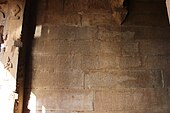
The complicated alliances of the empire and the five Deccan sultanates meant that he was continually at war. In one campaign, he defeated Golconda and captured its commander Madurul-Mulk, crushed Bijapur and its sultan Ismail Adil Shah,[34] and restored the Bahmani sultanate to the son of Muhammad Shah II.[35][page needed]
The highlight of his conquests occurred on 19 May 1520 where he secured Raichur Fort from Ismail Adil Shah after a difficult siege in which 16,000 Vijayanagara soldiers were killed. The exploits of the military commander, Pemmasani Ramalinga Nayudu of the Pemmasani Nayaks, during the Battle of Raichur were distinguished and lauded by Krishnadevaraya.[36] It is said that 700,000 foot soldiers, 32,600 cavalry, and 550 elephants were used.[37] A Portuguese contingent [38] commanded by Cristovão de Figueiredo[39] with the use of fireweapons helped to conquer the fortress.
Krishnadevaraya was brutal towards Bahmani Generals of Raichur. Many Bahmani generals lost their lands. The other Muslim kings sent envoys to the emperor on hearing of his success and received a haughty reply.[citation needed] The king conveyed that if Adil Shah would come to him, do obeisance, and kiss his foot, his lands would be restored to him. The submission never took place. Krishnadevaraya then led his army as far north as Bijapur and occupied it.[40][41] He imprisoned three sons of a former king of the Bahmani dynasty, who had been held captive by the Adil Shah and he proclaimed the eldest as king of the Deccan.[42]
Finally, in his last battle, he razed to the ground the fortress of Gulburga, the early capital of the Bahmani sultanate.
In 1524, Krishnadevaraya made his son Tirumala Raya the Yuvaraja (crown prince). The prince did not survive for long: he was poisoned.[43] Suspecting Timmarusu, Krishnadevaraya had him blinded.[44] At the same time, Krishnadevaraya was preparing for an attack on Belgaum, which was in the Adil Shah's possession. Around this time, Krishnadevaraya fell ill and eventually died in 1529, succeeded by his brother, Achyuta Deva Raya.[45]
Internal affairs

During his reign he kept strict control over his ministers, and dealt severely with any minister who committed misdeeds.[46] He abolished obnoxious taxes such as the marriage fee.[46] To increase revenues, he brought new lands under cultivation, ordering the deforestation of some areas[46] and undertook a large-scale work to obtain water for irrigation around Vijayanagara.[47][48] Foreign travellers such as Paes, Nunez and Barbosa who visited Vijayanagara spoke highly of the efficiency of his administration and the prosperity of the people during his reign.[46]
The administration of the empire was carried along the lines indicated in his Amuktamalyada. He was of the opinion that the King should always rule with an eye towards Dharma. His concern for the welfare of the people is amply proved by his extensive annual tours all over the empire, during which he studied everything personally and tried to redress the grievances of the people and punish evildoers. With regard to the promotion of the economic progress of his people, Krishnadevaraya says: "the extent of the kingdom is the means for the acquisition of wealth.[49] Therefore even if the land is limited in extent, excavate tanks and canals and increase the prosperity of the poor by leasing him the land for low ari and koru, so that you may obtain wealth as well as religious merit."[49]
Art and literature
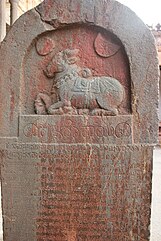
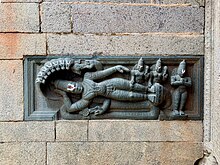
Krishnadevaraya was noted to be linguistically neutral as he ruled a multilingual empire. He is known to have patronised poets and issued inscriptions in languages as varied as Kannada, Sanskrit, Telugu and Tamil,. Krishnadevaraya himself was a polyglot, fluent in Kannada, Sanskrit, Telugu and Tamil. The official language of the Vijayanagara court was Kannada.[50]
Krishnadevaraya patronized literature in various languages. The rule of Krishnadevaraya was an age of prolific literature in many languages, although it is particularly known as a golden age of Telugu literature. Many Telugu, Kannada, Sanskrit, and Tamil poets enjoyed the patronage of the emperor, who was fluent in many languages.[51][52] The king himself composed an epic Telugu poem Amuktamalyada. His Sanskrit works include ‘Madalasa Charita’, ‘Satyavadu Parinaya’, ‘Rasamanjari’ and ‘Jambavati Kalyana’.
The Telugu poet Mukku Timmanna praised him as a great general and stated: "O Krishnaraya, you Man-Lion. You destroyed the Turks from far away with just your great name's power. Oh Lord of the elephant king, just from seeing you the multitude of elephants ran away in horror."[9]
Telugu literature

The rule of Krishnadevaraya is known as golden age of Telugu literature. Eight Telugu poets were regarded as eight pillars of his literary assembly and known as Ashtadiggajas. Krishna Dev Raya himself composed an epic Telugu poem Amuktamalyada.[53]
During the reign of Krishnadevaraya Telugu culture and literature flourished and reached their heyday. The great emperor was himself a celebrated poet having composed Amuktamalyada.[54] In the olden days, it was believed that eight elephants were holding the earth in eight different directions. The title Ashtadiggajas celebrates this belief and hence the court was also called Bhuvana Vijayam (Conquest of the World). This period of the Empire is known as the "Prabandha Period," because of the quality of the prabandha literature it produced.[54]
- Allasani Peddana is considered to be the greatest and given the title of Andhra Kavita Pitamaha (the father of Telugu poetry). Svarocisha Sambhava or Manucharita, his popular prabandha work, was dedicated to Krishnadevaraya
- Nandi Thimmana wrote Parijathapaharanam
- Madayyagari Mallana wrote Rajasekhara Charitramu
- Dhurjati wrote Kalahasti Mahatyamu and Kalahastisvara Satakamu
- Ayyalaraju Ramabhadrudu wrote Sakalakatha Sangraha and Ramaabhyudayamu
- Pingali Surana wrote Raghava Pandaviyamu, Kalapurnodayam and Prabhavate Pradyamana
- – Raghavapandaveeyamu is a dual work with double meaning built into the text, describing both the Ramayana and the Mahabharata.
- – Kalapurnodayam ("full bloom of art") has been considered the first original poetic novel in Telugu literature
- Battumurthy, alias Ramarajabhushanudu, wrote Kavyalankarasangrahamu, Vasucharitra, Narasabhupaliyam and Harischandranalopakhyanamu, a dual work which tells simultaneously the story of King Harishchandra and Nala and Damayanti
- Tenali Ramakrishna first wrote Udbhataradhya Charitramu, a Shaivite work. However, he later converted to Vaishnavism and wrote the Vaishnava devotional texts Panduranga Mahatmyamu, and Ghatikachala Mahatmyamu. Tenali Rama remains one of the most popular folk figures in India today, a quick-witted courtier ready even to outwit the all-powerful emperor.
Other well-known poets were Sankusala Nrisimha Kavi, who wrote Kavikarna Rasayana,[54] Chintalapudi Ellaya, who wrote Radhamadhavavilasa and Vishnumayavilasa, the poet Molla, who wrote a version of the Ramayana,[54] Kamsali Rudrakavi, who wrote Nirankusopakhyana,[54] and Addamki Gangadhara, who wrote Tapatlsamvarana[54] and Basavapurana.[clarification needed] Manumanchi Bhatta wrote a scientific work on veterinary science called Haya lakshanasara.[54]
Kannada literature
He patronised several Kannada poets. Among them Mallanarya, who wrote Veera-shaivamruta, Bhava-chinta-ratna and Satyendra Chola-kathe; Chatu Vittalanatha who wrote Bhagavatha and Timmanna Kavi wrote a eulogy of his king in Krishna Raya Bharata.[55][56] Vyasatirtha, the noted Dvaita saint from Mysore (of the Madhva tradition) was the emperor's Rajaguru ("royal guru").[57] The writing Krishna Deva Rayana Dinachari in Kannada is a recently discovered work.[58] The record highlights the contemporary society during Krishnadevaraya's time in his personal diary. However, it is not yet clear if the record was written by the king himself.
Purandara Dasa, "widely considered the father of Carnatic music" was closely associated with the empire. He extolled the Madhwa philosophy in his compositions and was a disciple of the Rajaguru of the emperor. According to Sambamoorthy,[59] he was born as Srinivasa and had his formal initiation by Vyasatirtha took place around 1525 when he was about 40 years of age, when he was given the name Purandara Dasa. Purandara Daasa traveled extensively in southern India composing and rendering them in praise of his god Purandara Vittala. He spent his last years in Hampi where he rendered his compositions in Krishnadevaraya's court.
Tamil literature
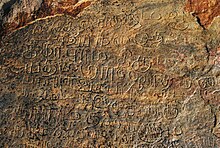
Krishnadevaraya patronised the Tamil poet Haridasa, and Tamil literature soon began to flourish as the years passed by.[60]
Sanskrit literature
In Sanskrit, Vyasatirtha wrote Bhedojjivana, Tatparyachandrika, Nyayamrita (a work directed against the Advaita philosophy) and Tarkatandava. Krishnadevaraya, himself an accomplished scholar, wrote Madalasa Charita, Satyavadu Parinaya and Rasamanjari and Jambavati Kalyana.[55][61][62]
Religion and culture
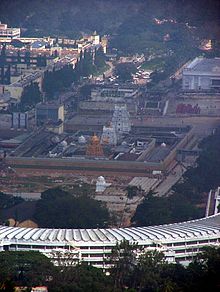

Krishnadevaraya respected all sects of Hinduism. He is known to have encouraged and supported various sects and their places of worship.[63] He rebuilt the Virupaksha Temple and other Shiva shrines. He gave land grants to the temples of Tirumala, Srisailam, Amaravati, Chidambaram, Ahobilam, and Tiruvannamalai.[63] He lavished on the Tirumala Venkateswara Temple numerous objects of priceless value, ranging from diamond studded crowns to golden swords to nine kinds of precious gems.[64] Krishnadevaraya made Venkateshwara his patron deity.[65] He visited the temple seven times.[65] Out of the around 1,250 temple epigraphs published by the Tirumala Devasthanam, 229 are attributed to Krishnadevaraya.[65] A statue of Krishnadevaraya with two of his wives is found at the temple complex of Tirumala.[66] These statues are still visible at the temple at the exit. He also contributed in building parts of the Srisailam temple complex where he had rows of mandapas built.[67]
Sri Vaishnavas claim that Krishnadevaraya himself was formally initiated into the Sri Vaishnava tradition and that's why he wrote a Telugu work on Andal, a Tamil Sri Vaishnava female saint, called the Amuktamalyada.[65] They claim that Venkata Tathacharya of the Sri Vaishnava sect was Krishnadevaraya's rajaguru, and he was considered influential.[65] But the Madhva text Vyasayogicarita the biography of Madhva seer Vyasatirtha says that the kulaguru of Krishnadevaraya. A manuscript from Madras Oriental Manuscript Library which is from a book written by Krishnadevaya himself in which Krishnadevaraya himself wrote that Vyasatirtha is his Rajaguru."[68]
See also
Notes
- ^ 14 Magha 1431 Shaka Samvat
References
- ^ a b Advanced Study in the History of Medieval India by Jl Mehta p. 118
- ^ Pollock, Sheldon (2003). The Language of the Gods in the World of Men: Sanskrit, Culture, and Power in Premodern India. University of California Press. p. 179. ISBN 0-5202-4500-8.
- ^ Srinivasan, C. R. (1979). Kanchipuram Through the Ages. Agam Kala Prakashan. p. 200. OCLC 5834894. Retrieved 25 July 2014.[ISBN missing]
- ^ Sewell, R. (1915). "The Kings of Vijayanagara, A.D. 1486-1509". The Journal of the Royal Asiatic Society of Great Britain and Ireland. [Cambridge University Press, Royal Asiatic Society of Great Britain and Ireland]: 383–395. ISSN 0035-869X. JSTOR 25189336. Retrieved 22 October 2024.
- ^ Sivasankaranarayana, Bh.; Rajagopal, M. V.; Ramesan, N. (1970). Andhra Pradesh District Gazetteers: Anantapur. Director of Print. and Stationery at the Government Secretariat Press, copies can be had from:Government Publication Bureau. p. 63.[ISBN missing]
- ^ T. K. T. Viraraghavacharya (1997). History of Tirupati: The Thiruvengadam Temple, Volume 2. Tirumala Tirupati Devasthanams. p. 469.
- ^ Tabasum Bhanu (2015) Sri krishnadevaraya 1509-1529.made vijayanagara a military power in the south an overview IJCRT 3(4)
- ^ a b Keay, John, India: A History, New York: Harper Collins, 2000, p. 302
- ^ a b Vijayanagara Voices: Exploring South Indian History and Hindu Literature William Joseph Jackson: p. 124
- ^ Prof K.A.N. Sastri, History of South India, From Prehistoric times to fall of Vijayanagar, 1955, pp. 250, 258
- ^ Pollock, Sheldon (2011). Forms of Knowledge in Early Modern Asia: Explorations in the Intellectual History of India and Tibet, 1500–1800. Durham and London: Duke University Press. p. 72. ISBN 978-0822349044. OCLC 1171392877.
- ^ Temple, Richard Carnac, ed. (1985). Indian Antiquary. Vol. 27. Delhi: Swati Publications. p. 276.
Nộisimha had two sons, Viranşisinha and Kșishộarâya, the former by one of his queens Tippâmbân,Nagamâmbâ.
[ISBN missing] - ^ Mallappa, T. N. (1974). Kriyasakti Vidyaranya. Bangalore: Department of Publications & Extension Lectures, Bangalore University. p. 149. OCLC 2202269.
In those days , king was regarded as God Vishnu , but in the case of Krishnadevaraya , such a feeling could not be expected as he was the son of an usurper of the kingdom by his concubine.
[ISBN missing] - ^ "Krishnadevaraya (1471 AD −1530 AD) of Vijaynagar empire who destroyed turks terribly". 30 March 2023. Retrieved 15 April 2023.
- ^ H. V. Sreenivasa Murthy, R. Ramakrishnan (1977). A History of Karnataka, from the Earliest Times to the Present Day. S. Chand. p. 188.
- ^ P. Sree Rama Sarma (1992). A History of the Vijayanagar Empire. Prabhakar Publications. p. 135.
The invaders were checked at Diwani (Unidentified). In a hotly contested battle fought at Diwani the Sultan himself was thrown off his horse. He sustained serious injuries.
- ^ Karnataka State Gazetteer: Dharwad District (including Gadag and Haveri Districts). Office of the Chief Editor, Karnataka Gazetteer. 1993. p. 53.
- ^ P. Raghunadha Rao (1993). Ancient and Medieval history of Andhra Pradesh. Sterling Publishers. p. 87.
Timmarasu himself took command, defeated the Golconda army and captured its commander Madurl Mulk
- ^ Cohen, B. (2007). Kingship and Colonialism in India's Deccan 1850–1948. Springer. p. 47. ISBN 978-0-230-60344-8.
Vijayanagar king Krishnadevaraya opted to march against the Qutb Shah leader. He came with 30,000 horses and 3,000 foot soldiers. Quli Qutb responded, and the two armies met at Pangal where the Vijayanagar army had encamped. In battle, the Golconda forces were successful, forcing the retreat of Krishnadevaraya who left behind a small force to defend the fort. The fort occupants held out for nearly two months before capitulating to the besieging Qutb Shah forces.
- ^ Panigrahi, Krishna Chandra. History of Orissa. pp. 191, 194–196.
- ^ N. K. Sahu, P. K. Mishra, Jagna Kumar Sahu (1981). History of Orissa. Nalanola. p. 234.
Krishnadevaraya started his expedition against Udayagiri early in A.D. 1512.
{{cite book}}: CS1 maint: multiple names: authors list (link) - ^ Life and Achievements of Sri Krishnadevaraya. Directorate of Archaeology and Museums, Government of Karnataka. 2011. p. 48.
Starving the defenders into surrender seemed to be the only way open to the Raya.
- ^ Life and Achievements of Sri Krishnadevaraya. Directorate of Archaeology and Museums, Government of Karnataka. 2010. p. 48.
A relieved Raya left for the capital and on the way visited the temple of Tirupati and gave numerous gifts to the Lord in gratefulness for the victory at Udaygiri.
- ^ Life and Achievements of Sri Krishnadevaraya. Directorate of Archaeology and Museums, Government of Karnataka. 2010. p. 47.
The Raya's soldiers had to virtually blast their way through huge boulders to go anywhere near the foot of the fort wall … The Gajapati did such a fine job of defending the fort that the siege dragged on for fourteen months.
- ^ Achintya Kumar Deb (1984). The Bhakti Movement in Orissa: A Comprehensive History. Kalyani Devi. p. 27.
Pratapurdradeva could not protect it [Kondaveedu Fort] and he surrendered several military and civil officers, including Virabhadra, son of Prataparudredeva were taken captives by the king of Vijayanagar.
- ^ "Imperial Gazetteer 2 of India, Volume 15, pp. 393 – Imperial Gazetteer of India – Digital South Asia Library". dsal.uchicago.edu. Retrieved 10 May 2021.
- ^ Andhra Pradesh (India). Dept. of Archaeology (1962). Andhra Pradesh Government Archaeological Series. Government of Andhra Pradesh. p. 15.
Krishnadevaraya went as far as Cuttack
- ^ N. Saraswathi Nanaiah (1992). The Position of Women During Vijayanagara Period, 1336–1646. Southern Printers. p. 135.
When Krishnadeva Raya won against Gajapathi, he gave a lot of dowry to Krishnadeva Raya and gave his
- ^ K. Jayasree (1991). Agrarian Economy in Andhra under Vijayanagar. Navrang. p. 21. ISBN 978-8170130840.
Krishnadevaraya returned all the territory north of the river Krishna to Prataparudra Gajapati.
- ^ Bowman, John (2000). Columbia Chronologies of Asian History and Culture. Columbia University Press. p. 272. ISBN 978-0231500043.
Krishnadevaraya pursues friendly relations with Europeans, granting Portuguese trading rights in exchange for access to trade goods.
- ^ Powell, Salem (2001). Magill's Guide to Military History. Salem Press. p. 1609. ISBN 978-0893560140.
the importation and use of Arabian war horses and guns [by the Vijayanagara Empire].
- ^ Directorate of Archaeology and Museums (2010). Life and Achievements of Sri Krishnadevaraya. Government of Karnataka. p. 267.
The rulers of Vijayanagara and Bahmanis mainly depended on Portuguese and Arabs for the import of quality horses for military operations.
- ^ I. M. Muthanna (1962). Karnataka, History, Administration & Culture. p. 38.
He [Krishnadevaraya] erected a huge embankement near Hosept with the assistance of the Portuguese engineers.
- ^ PSR (Standard Issue) (2009). Portuguese Studies Review, Vol. 16, No. 2. Baywolf Press. p. 27.
In 1520, Ismail Adil Shah recaptured the Raichur Doab from Vijayanagara. In May 1520, Krishnadevaraya sent his forces to Raichur and in the battle that ensued, Adil Shah was defeated and his forces were routed.
- ^ Sharma, L.P (1987). History of Medieval India (1000–1740 A.D.). Konark Publishers. ISBN 978-8122000429.
However, he [Krishnadevaraya] returned after placing on the throne the eldest son of Muhammad Shah II.
- ^ G. Surya Prakash Rao (2004). Krishnadeva Raya: The Great Poet-emperor of Vijayanagara. Potti Sreeramulu Telugu University. p. 36.
in this battle, Pemmasani Ramalinga Naidu, the Kamma chief of Gandikota family, distinguished himself from the Vijayanagara side.
- Jackson, William (2016). Vijayanagara Voices: Exploring South Indian History and Hindu Literature. Routledge. pp. Ramalinga Nayadu received a token gift from the king. ISBN 978-1317001935.
124
- Tidings of the king : a translation and ethnohistorical analysis of the Rāyavācakamu. Wagoner, Phillip B., Honolulu: University of Hawaii Press. 1993. ISBN 0585338191. OCLC 45885573. p. 59: Quote: "Pemmasani Ramalinga Nayudu bravely offers to counter this move of the Turks by going with his men to infiltrate their camp."
- "Journal of the Andhra Historical Society". Andhra Historical Research Society, Rajahmundry, Madras, Andhra Historical Research Society. Volume 30: 91 "Ramalingatiayudu, who succeeded his father, was one of the most redoubtable warriors- in the court of Krishnadgvarlya. ... Rachuru (Raichur) and other strong places with his [Pemmasani Ramalinga] own men and prepared to proceed against the city of Golconda. ... Pemmasani Ramalinganayudu entered the thickest of the fight". 1964.
- Rajasekhara, Sindigi (2008). The Map Approach to Vijayanagara history. University of Michigan and Sujatha Publications. p. 34.
- Jackson, William (2016). Vijayanagara Voices: Exploring South Indian History and Hindu Literature. Routledge. pp. Ramalinga Nayadu received a token gift from the king. ISBN 978-1317001935.
- ^ Reddy, Kittu (2003). History of India: A New Approach. Standard Publishers. p. 184.
It is said that his army consisted of about a million men, with over 700,000 fighting men and 550 elephants …
- ^ "Ismāʿīl ʿĀdil Shāh | Bijāpur ruler | Britannica". www.britannica.com. Retrieved 5 December 2023.
- ^ "Portuguese Studies Review, Vol. 16, No. 2". 15 December 2009.
- ^ Eaton 2013, p. 292.
- ^ Vijayanagara, Progress of Research, Directorate of Archaeology & Museums, 1996, p. 200
- ^ Sandhu, Gurcharn Singh (2003). Military History of Medieval India. Vision Books. p. 342.
- ^ Pandurang Bhimarao Desai (1970). A History of Karnataka: From Pre-history to Unification. Kannada Research Institute, Karnataka University. p. 371.
Raya crowned his six-years-old son Tirumala as yuvaraja and introduced him to the affairs of the state But within one year the young prince died. It was reported that he was a victim of poison...
- ^ P. Raghunadha Rao (1993). Ancient and Medieval history of Andhra Pradesh. Sterling Publishers. p. 88.
Krishnadeva Raya learnt that his son was poisoned by Timma, the son of his great minister Timmarasu. Both the son and father were captured and blinded.
- ^ Pran Nath Chopra; B.N. Puri; M.N. Das (2003). A Comprehensive History of India: Comprehensive history of medieval India. Sterling Publishers. p. 93. ISBN 9788120725089 – via Google Books.
- ^ a b c d A Comprehensive History of India: Comprehensive history of medieval India by B.N. Puri, M.N. Das p. 94
- ^ Economic History of Medieval India, 1200–1500 p. 194
- ^ History of Medieval India: From 1000 A.D. to 1707 A.D. by Radhey Shyam Chaurasia p. 111
- ^ a b Medieval Indian History by Krishnaji Nageshrao Chitnis p. 82
- ^ Dr. Suryanath U. Kamat 2001, p. 166.
- ^ "The Hindu : Andhra Pradesh / Tirupati News : Krishnadevaraya was Telugu: V-C". Archived from the original on 21 April 2013. Retrieved 22 September 2012.
- ^ "The Hindu : Entertainment Chennai / Music : Genius of Vaidyanatha Iyer". Archived from the original on 14 September 2006.
- ^ N. Jayapalan (2001). History of India. Atlantic Publishers & Distributors (P) Limited. p. 92. ISBN 978-8171569281.
- ^ a b c d e f g P. Chenchiah (1928). A History of Telugu Literature (PDF). The Association Press and the Oxford University Press. p. 69.
- ^ a b Dr. S.U. Kamat, Concise history of Karnataka, pp. 157–189
- ^ Prof K.A.N. Sastri, History of South India pp. 355–366
- ^ Krishna Deva Raya considered the saint his Kula-devata and highly honored him. A Concise History of Karnataka p. 178, Dr. S.U. Kamath, [1] Haridasas of Karnataka, Madhusudana Rao CR, History of South India, p. 324, Prof. K.A.N. Sastri
- ^ A Concise History of Karnataka, Dr. S.U. Kamath, p. 157
- ^ Friday Review Chennai and Tamil Nadu. Columns: An authority on Purandara Dasa. The Hindu. 20 October 2006.
- ^ Dr. S.U. Kamat, Concise history of Karnataka, pp. 157–189, History of South India, pp. 331–354, Prof. K.A.N. Sastri
- ^ Prof K.A.N. Sastri, History of South India pp. 239–280
- ^ Prof K.A.N. Sastri, History of South India pp. 309–330
- ^ a b Jackson, William J. (2016). Vijayanagara Voices: Exploring South Indian History and Hindu Literature. Routledge. p. 175. ISBN 978-1-317-00193-5.
- ^ Reddy, Pedarapu Chenna; Subrahmanyam, B. (2011). Gifts and Grants by Sri Krishnadevaraya: During His Visit to the Temples in Andhradesa. Department of Archaeology and Museums, Government of Andhra Pradesh. p. 148.
- ^ a b c d e Rao, Ajay K. (2014). Re-figuring the Ramayana as Theology: A History of Reception in Premodern India. Routledge. pp. 101–102. ISBN 978-1-134-07742-7.
- ^ Jackson, William J. (2007). Vijaynagar Visions: Religious Experience and Cultural Creativity in a South Indian Empire. OUP India. p. 176. ISBN 978-0-19-568320-2.
- ^ Reddy, Pedarapu Chenna; Subrahmanyam, B. (2011). Gifts and Grants by Sri Krishnadevaraya: During His Visit to the Temples in Andhradesa. Department of Archaeology and Museums, Government of Andhra Pradesh. p. 99.
- ^ "Nagari Script". Department of Archeology, Government of Tamil Nadu.
Sources
- Eaton, Richard M. (2013), "'Kiss My Foot,' Said the King: Firearms, Diplomacy and the Battle for Raichur, 1520", in Richard M. Eaton; Munis D. Faruqui; David Gilmartin; Sunil Kumar (eds.), Expanding Frontiers in South Asian and World History: Essays in Honour of John F. Richards, Cambridge University Press, pp. 275–298, ISBN 978-1-107-03428-0
- Smith, Vincent, Oxford History of India, 4th ed., pp. 306–307, 312–313.
- Dr. Suryanath U. Kamat (2001), Concise history of Karnataka, MCC, Bangalore (Reprinted 2002)
- Prof K.A. Nilakanta Sastri, History of South India, From Prehistoric times to fall of Vijayanagar, 1955, OUP, New Delhi (Reprinted 2002)
External links
- The Golden Era of Telugu Literature from the Vepachedu Educational Foundation
- Krishnadevaraya's complex at Tirupati
- Statues of Krishnadevaraya and his wives at Tirupati.
- Gold coins issued during Krishnadevaraya's reign
- A Forgotten Empire (Vijayanagara): a contribution to the history of India (Translation of the Chronica dos reis de Bisnaga written by Domingos Paes and Fernão Nunes about 1520 and 1535, respectively, with a historical introduction by Robert Sewell)
